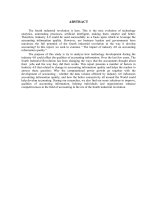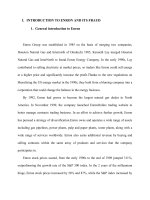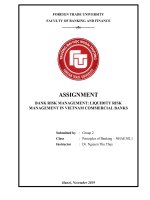(Tiểu luận) management information systemsfinal projectgoogle analytics
Bạn đang xem bản rút gọn của tài liệu. Xem và tải ngay bản đầy đủ của tài liệu tại đây (2.13 MB, 66 trang )
<span class="text_page_counter">Trang 1</span><div class="page_container" data-page="1">
HO CHI MINH CITY UNIVERSITY OF ECONOMICS AND FINANCE FACULTY OF INFORMATION TECHNOLOGY
<b>MANAGEMENT INFORMATION SYSTEMS</b> Nguyen Thi Hang – 205120982 Duong Thanh Liem – 205121025 Nguyen Diem Tuyet – 205120724 Nguyen Ngoc Bao Han - 205120457
LECTURER: Pham Su Tien Trinh
Ho Chi Minh City, December 28 , 2022
</div><span class="text_page_counter">Trang 2</span><div class="page_container" data-page="2">3.2 How Google Analytics Works ? ...20
3.2.1 Google analytics works based on 4 main stages...20
3.2.2 Competition...21
3.3 Why choose Google Analytics?...23
3.3.1 Free...23
3.3.2 Analyze traffic sources (traffic)...23
3.3.3 Provide demographic information about website visitors...24
3.3.4 Determine which pages are most attractive to customers...24
3.3.5 Bounce rate...24
3.3.6 Keywords...25
3.3.7 Traffic...25
</div><span class="text_page_counter">Trang 3</span><div class="page_container" data-page="3">3.4 Conclusion ...25
3.5 Basic concepts and metrics of Google Analytics...26
3.5.1 Concepts...26
3.5.2 Metrics Used In Google Analytics...26
3.6 Features of Google Analytics...31
3.6.1 Reporting and Visualisation...32
4.1 Strengths of Google Analytics...35
4.2 Weaknesses of Google Analytics...35
4.3 Opportunities for Google Analytics...36
4.4 Threats for Google Analytics...36
<b>5.Demo... 37</b>
5.1 How to create an account...37
5.2 How to use it...45
5.3 Realtime report...46
5.4 Life cycle collection...48
5.4.1 User acquisition report...49
5.4.2 Traffic acquisition report...50
5.4.3 Events report...50
5.4.4 Conversions report...50
</div><span class="text_page_counter">Trang 4</span><div class="page_container" data-page="4">5.4.5 Pages and screens report...51
5.4.6 Ecommerce purchases report...51
5.4.7 In-app purchases report...51
5.4.8 Publisher ads report...52
5.4.9 Retention reports...52
5.5 Google Analytics for Marketing...53
5.5.1 Use Google Analytics to increase traffic...53
</div><span class="text_page_counter">Trang 5</span><div class="page_container" data-page="5"><b>TABLE OF FIGURES</b>
Figure 1: The concept of MIS. (Chetan, 2015)...9
Figure 2: Lenovo Company. (Strategies, 2015)...14
Figure 3:SimilarWeb. (Nguyễn, 2020)...21
Figure 4: Alexa – Free competitor research tool. (Wikipedia, 2022)...22
Figure 5: Google Alert – The best tool to control the amount of Mentions. (Wikipedia, Google Alerts, 2022)...23
Figure 6: User-Visitor in GA4. (Luân, 2022)...26
Figure 7: Pageview details in GA4. (GA4, 2022)...27
Figure 8: Average time per sessions overview. (GA4, 2022)...28
Figure 9: Average time per sessions overview. (GA4, 2022)...29
Figure 10: Average time per sessions overview. (GA4, 2022)...30
Figure 11: Bounce Rate overview. (GA4, 2022)...30
Figure 12: Conversion Rate. (GA4, 2022)...31
Figure 13: Google marketing platform information. (Google, 2022)...37
Figure 14: Property details in GA4. (GA4, 2022)...39
Figure 15: Business Information in GA4. (GA4, 2022)...40
Figure 16: Set up a data stream. (GA4, 2022)...40
Figure 17: Enhanced measurement in GA4. (GA4, 2022)...41
Figure 18: Additional Settings in GA4. (GA4, 2022)...42
Figure 19: Web stream details. (GA4, 2022)...43
Figure 20: Configure your Setup. (GA4, 2022)...44
</div><span class="text_page_counter">Trang 6</span><div class="page_container" data-page="6">Figure 21: Verify your setup. (GA4, 2022)...44
Figure 22: Way to access Report in GA4. (GA4, 2022)...45
Figure 23: The Reports snapshot in GA4. (GA4, 2022)...46
Figure 24: Way to access Real-time reports in GA4. (GA4, 2022)...47
Figure 25: Life cycle in GA4. (GA4, 2022)...49
Figure 26: Overview of GA4. (GA4, 2022)...53
Figure 27: Statistics on how people come to the web. (GA4, 2022)...54
Figure 28: Overview about information in GA4. (GA4, 2022)...55
Figure 29: Overview of all users. (GA4, 2022)...56
Figure 30: Minor dimension and major dimension in GA4. (GA4, 2022)...56
Figure 31: Number of users by time of day. (GA4, 2022)...57
Figure 32: Information sharing interface in excel. . (GA4, 2022)...57
<b>LIST OF ABBREVIATIONS</b>
<b>MISManagement Information Systems</b>
<b>ITInformation Technology</b>
</div><span class="text_page_counter">Trang 7</span><div class="page_container" data-page="7"><b>THANK YOU</b>
To complete the subject project "Management Information System", first of all, we would like to express our sincere and deep thanks to the teachers of the University of Economics and Finance of Ho Chi Minh City.
In particular, we would like to thank Mr. Pham Su Tien Trinh - who enthusiastically guided and helped us acquire knowledge and complete the project in the most complete and complete way.
Because of our limitations, in the process of practicing our knowledge and completing this project, we inevitably make mistakes. We look forward to receiving your comments and suggestions.
Finally, I wish you good health and success in your noble career. We sincerely thank you.
</div><span class="text_page_counter">Trang 8</span><div class="page_container" data-page="8">Today Information Technology has developed at a rapid pace in the 4.0 era. Information technology has been applied in many fields through scientific research, economic development, military and various art forms. In advanced countries, computers have been applied in many fields to serve the interests of people. The world is closer together thanks to Information Technology. We are living in an era where data becomes an extremely valuable and useful resource for many industries and fields. Therefore, the data analysis industry is also more focused and popular.
Therefore, the introduction of products to support large enterprises in managing, analyzing and synthesizing data in recent years has brought many advantages and optimized performance for those enterprises. So, our team chose the topic of Google Analytics, a leading tool in the field of data analysis, synthesis and management in the world today, especially through
</div><span class="text_page_counter">Trang 9</span><div class="page_container" data-page="9">the case study of Lenovo company to understand the field. What is an area and how to use the Google Analytics tool. Besides learning and studying these data, our team also wants to show people how to use this tool specifically through the Demo section.
With the consent and support of Lecturer Pham Su Tien Trinh, subject of Management Information Systems, our group had the opportunity to carry out the topic: "Researching Google Analytics and Lenovo's case study".
</div><span class="text_page_counter">Trang 10</span><div class="page_container" data-page="10">1. Introduce MIS 1.1 What is MIS?
A management information system (MIS) is a system for collecting, storing, processing, organizing and analyzing business data and turning them into actionable intelligence. The more complex a company's operations are, the more complex its MIS is likely to be. An MIS is used to significantly improve the efficiency of report generation and data analysis by taking the information gathered by various members of staff and storing it in a uniform and accessible manner.
The latest MIS operations use cloud technology and can monitor results of data analysis in real-time, track changes in productivity over a period of time, respond to data-related questions and highlight data that corresponds to current requirements. Depending on an organization's size, it may have an MIS department with a team of trained IT professionals to manage its complex data needs. Along with the company's decision-makers, many of its other employees may also be able to access and use the MIS data.
Figure 1: The concept of MIS. [ CITATION Kum15 \l 1066 ]
</div><span class="text_page_counter">Trang 11</span><div class="page_container" data-page="11">1.2 The concept of MIS
<b>MANAGEMENT: Management has been defined in process or </b>
activities that describe what managers do in the operation for their organization plan, organize, initiate and control operations. They plan by setting strategies and goals and selecting the best course of action to achieve the goals. They organize the necessary tasks for the operational plan, set these tasks up into homogeneous groups and assign authority delegation; they control the performance standards and avoid deviation from standard.
The decision-making is a fundamental prerequisite of each of the foregoing processes, the job of MIS is facilitating decisions necessary for planning, organizing and controlling the work and functions of the business so that specified goals of business are achieved.
<b>INFORMATION: Data must be distinguished from information and </b>
the distinction is clear and important for present purpose. Data are facts and figures that are not currently being used in a decision-making process and usually are taken from the historical records that are recorded and filled without immediate intent to retrieve for decision-making.
Information consists of data that have been retrieved, processed or otherwise used for information or interference purpose, argument or as a basis forecasting or decision-making regarding any business unit. Information is knowledge that one derives from facts for effective functioning of systems placed in the right context with the purpose of reducing uncertainty regarding the alternative courses of action as they are based on description and measurement of attributes of various entities associated with the enterprise.
</div><span class="text_page_counter">Trang 12</span><div class="page_container" data-page="12"><b>SYSTEM: The system can be described as a set of elements joined </b>
together for a common objective. A subsystem is a part of a larger system with which one is concerned. All systems for our purpose the organization is the system and the parts (divisions, departments, functions, unit etc) are the subsystem.
The system concept of MIS is, one of optimizing the output of the organization by connecting the operating subsystems through the medium of information exchange.
1.3 Benefits of MIS
The benefits of MIS in business can include the following:
<b>It allows real-time performance reports</b>
By receiving performance reports in real-time, the organization can become more dynamic in its operations. Its employees may be able to discover and respond to opportunities more quickly. They may also be able to detect potential threats and find appropriate solutions to avoid or minimize them. Additionally, when everyone is better-informed about the business operations and long-term results, their work productivity may improve.
<b>It generates analytical reports</b>
The principal function of MIS is to organize and analyze data and use it to generate informative reports. With these reports, the organisation's management can monitor its performance and identify new business opportunities. They can formulate plans to improve the organization's processes and increase its production efficiency.
<b>It compares projections and performances</b>
Organizations regularly set business goals and make business and financial forecasts, but they need to monitor their effectiveness. For that, they must compare them with actual performances. An MIS facilitates
performance reviews and accurate comparisons with the projections. That can enable the management to make better business decisions.
</div><span class="text_page_counter">Trang 13</span><div class="page_container" data-page="13"><b>It aids the work allocation process</b>
With an MIS information system, the organization's management can make better decisions concerning the allocation of staff and resources. They can review the performance reports of individual employees and departments and identify the best performers. To enhance work productivity and get better business results, they can transfer the best employees to the high-performing departments. They can also arrange for training programmes to improve the performances of the employees and departments that have not been doing as well.
<b>It improves internal communication</b>
It can facilitate communication between different employees and departments of the organization. They can share relevant and timely business information, particularly about interdepartmental work. That can prevent work delays or misuse of resources due to any misunderstanding or lack of discussion. For instance, when two departments require different parts or materials that the organization must order from a foreign supplier, it is more convenient and economical to place an order together, rather than separate orders that could cause delays in arrival.
2. Case Study Lenovo Company Lenovo
Lenovo Group Ltd. or Lenovo PC International, often shortened to Lenovo, is a Chinese multinational technology company with headquarters in Beijing, China and Morrisville, North Carolina. It designs, develops, manufactures and sells personal computers, smart phones, workstations, servers, electronic storage devices, IT management software, and smart televisions. Lenovo is the world's largest personal computer vendor by unit sales since 2013. It markets the ThinkPad line of notebook computers, Idea
</div><span class="text_page_counter">Trang 14</span><div class="page_container" data-page="14">Pad, Yoga and Legion lines of notebook laptops, and the Idea Centre and Think Centre lines of desktops.
Lenovo has operations in more than 60 countries and sells its products in around 160 countries. Lenovo's principal facilities are in Beijing and Morrisville, with research centers in Beijing, Shanghai, Shenzhen, Xiamen, Chengdu, Nanjing, and Wuhan in China, Yamato in Kanagawa Prefecture, Japan and Morrisville in the U.S. It operates a joint venture with EMC called Lenovo EMC, which sells network-attached storage solutions. It also has a joint venture with NEC, Lenovo NEC Holdings, which produces personal computers for the Japanese market.
Lenovo was founded in Beijing in November 1984 as Legend and was incorporated in Hong Kong in 1988. Lenovo acquired IBM's personal computer business in 2005 and agreed to acquire its Intel-based server business in 2014. Lenovo entered the smart phone market in 2012 and as of 2014 was the largest vendor of smart phones in Mainland China.
In 2001, Lenovo introduced the Six Sigma method from Motorola, which was formally adopted as an important part of the continuous improvement system, and became the first Chinese enterprise to officially introduce the Six Sigma Black Belt Training Consulting Project.
Lenovo Group divides Six Sigma management into three levels. The first level: Define the strategic goal of enterprise quality management: The customer-centered quality management concept is reflected in Lenovo's core values: serving customers, accurate and realistic, honest sharing, and entrepreneurial innovation. The second level is to establish a continuous improvement mechanism based on Six Sig's core around the entire process of product realization. The third level: support for strategic goals, personnel training and development, quality information, quality costs, and cultural awareness. At the implementation process level, the continuous improvement mechanism is placed in a prominent position alongside the quality assurance
</div><span class="text_page_counter">Trang 15</span><div class="page_container" data-page="15">system. The aim is to continuously improve the quality assurance system through the establishment of a continuous improvement mechanism. At the same time, Six Sigma management will be the core of the continuous improvement mechanism, so that Six Sigma management will be fully integrated with the company. The quality management system is integrated.
At present, Lenovo has established its own Six Sigma green belt, black belt training system and certification system, and has carried out extensive promotion and application within the scope of Lenovo Group Corporation. The specific implementation process of Lenovo Group Six Sigma adopts a combination of theory and practice, and it is very much focused on “doing high school”. After the first phase of training is completed, trainees are required to do the project. In each of the five stages of studying Six Sigma, the students must go back and do the project whenever they complete a course in the course of the course. Only after they have achieved the required degree can they come back to attend classes.
Figure 2: Lenovo Company. [ CITATION Mar15 \l 1066 ]
</div><span class="text_page_counter">Trang 16</span><div class="page_container" data-page="16">2.1 Summary Issue.
View marketing programs holistically.
Optimize spend across channels, not just within channels.
Confidently allocate additional marketing budget to drive incremental sales.
Adopted a data-driven attribution approach with Adometry.
Integrated data from existing systems of record, Adobe, and DoubleClick. Reanalyzed results to ensure fully-attributed results mirrored actual sales data.
Gained a complete and accurate view of its cross-channel marketing efficacy. Uncharted territory.
Marketers face challenges in applying modern, cross-channel measurement techniques within the construct of outdated management approaches in which each channel is measured and optimized in a silo. Rules-based measurement techniques built around clicks make it commonplace for multiple channel owners to claim credit for the same conversions or sales.
Everyone knows this approach is flawed—and inconsistent with a holistic, cross-channel marketing strategy. But how do marketing leaders push wholesale change when alternative measurement methodologies seem too difficult or unfamiliar?
It often boils down to vision and a willingness to throw out old assumptions and let the data convey a new story.
2.2 Solution
Lenovo discovered a new marketing picture after working with Adometry for just six months. After integrating data from existing systems of record, Adobe and DoubleClick, it reanalyzed results using cross-channel fractional
</div><span class="text_page_counter">Trang 17</span><div class="page_container" data-page="17">credit to ensure fully-attributed results mirror actual sales data. Additionally, the company learned:
Not surprisingly for a popular brand such as Lenovo, direct navigation and organic search are in the top three for overall revenue (display is second); however, a significant portion of conversions are attributed to multiple channels. An integrated mix is a key aspect of Lenovo's strategy.
The percentage of revenue resulting from multi-touch conversion paths (73%) as well as the extent to engagement spanned multiple channels (63%), meaning consumers are being reached by multiple programs and a variety of channels within Lenovo's mix.
By reporting on revenue performance and efficiency by channel, Lenovo identified that comparison shopping engines (CSEs)—which the company had considered eliminating because of a perceived low overall contribution to sales—actually provided the best performance. CSEs have about 42% better ROAS than the next-best channel. Not only is Lenovo continuing to use CSEs in new marketing plans, it is looking for ways to leverage the channel for even better results.
When looking at channels by funnel stage (introducers, promoters, and closers), the channels that act as closers offered no surprises. However, Lenovo didn't realize how much branded display, paid social, paid search, and organic social are responsible for taking prospects to the next step as introducers and promoters in the conversion path. Armed with a new view of performance in these channels, Lenovo will optimize investments and drive greater sales.
</div><span class="text_page_counter">Trang 18</span><div class="page_container" data-page="18">3. Analysis
3.1 About Google Analytics 3.1.1 History
Google acquired Urchin Software Corp. in April 2005. Google's service was developed from Urchin on Demand. The system also brings ideas from Adaptive Path, whose product, Measure Map, was acquired and used in the redesign of Google Analytics in 2006. Google continued to sell the standalone, installable Urchin WebAnalytics Software through a network of value-added resellers until discontinuation on March 28, 2012. The Google-branded version was rolled out in November 2005 to anyone who wished to sign up. However, due to extremely high demand for the service, new sign-ups were suspended a week later. As capacity was added to the system, Google began using a lottery-type invitation-code model. Before August 2006, Google was sending out batches of invitation codes as server availability permitted; since mid-August 2006 the service has been fully available to all users – whether they use Google for advertising or not.
The newer version of Google Analytics tracking code is known as the asynchronous tracking code, which Google claims is more sensitive and accurate, and is able to track very short activities on the website. The previous version delayed page loading, and so, for performance reasons, it was generally placed just before the </body> body close HTML tag. The new code can be placed between the <head> ... </head> HTML head tags because, once triggered, it runs in parallel with page loading. In April 2011 Google announced the availability of a new version of Google Analytics featuring multiple dashboards, more custom report options, and a new interface design. This version was later updated with some other features such as real-time analytics and goal flow charts.
</div><span class="text_page_counter">Trang 19</span><div class="page_container" data-page="19">In October 2012 another new version of Google Analytics was announced, called Universal Analytics. The key differences from the previous versions were: cross-platform tracking, flexible tracking code to collect data from any device, and the introduction of custom dimensions and custom metrics.
In March 2016, Google released Google Analytics 360, which is a software suite that provides analytics on return on investment and other marketing indicators. Google Analytics 360 includes seven main products: Analytics, Tag Manager, Optimize, Data Studio, Surveys, Attribution, and Audience Center.
In October 2017 a new methodology to collect data for Google Analytics was announced, called Global Site Tag, or gTag.js. Its stated purpose was to unify the tagging system to simplify implementation. This new tag type is an alternative to the existing Analytics.js tag type or Google Tag Manager.
In June 2018, Google introduced Google Marketing Platform, an online advertisement and analytics brand. It consists of two former brands of Google, DoubleClick Digital Marketing and Google Analytics 360. In October 2020, Google released Google Analytics 4, under the acronym GA4. Instead of being "hit-based," like Universal Analytics, GA4 is "event-based." In March 2022, Google announced that on July 1, 2023, standard Universal Analytics properties will stop processing new hits. Users will need to upgrade to GA4.
3.1.2 Technology
Google Analytics is implemented with "page tags", in this case, called the Google Analytics Tracking Code, which is a snippet of JavaScript code that the website owner adds to every page of the website. The tracking code runs in the client browser when the client browses the page (if JavaScript is
</div><span class="text_page_counter">Trang 20</span><div class="page_container" data-page="20">enabled in the browser) and collects visitor data and sends it to a Google data collection server as part of a request for a web beacon.
The tracking code loads a larger JavaScript file from the Google web server and then sets variables with the user's account number. The larger file (currently known as ga.js) was typically 40 kB as of May 2018.
The file does not usually have to be loaded, however, due to browser caching. Assuming caching is enabled in the browser, it downloads ga.js only once at the start of the visit. Furthermore, as all websites that implement Google Analytics with the ga.js code use the same master file from Google, a browser that has previously visited any other website running Google Analytics will already have the file cached on their machine.
In addition to transmitting information to a Google server, the tracking code sets a first party cookie (If cookies are enabled in the browser) on each visitor's computer. This cookie stores anonymous information called the ClientId. Before the launch of Universal Analytics, there were several cookies storing information such as whether the visitor had been to the site before (new or returning visitor), the timestamp of the current visit, and the referrer site or campaign that directed the visitor to the page (e.g., search engine, keywords, banner, or email).
3.1.3 Definition
Google Analytics is a web analytics service that provides statistics and basic analytical tools for search engine optimization (SEO) and marketing purposes. The service is part of the Google Marketing Platform and is available for free to anyone with a Google account.
Google Analytics is used to track website performance and collect visitor insights. It can help organizations determine top sources of user traffic, gauge the success of their marketing activities and campaigns, track goal completions (such as purchases, adding products to carts), discover patterns
</div><span class="text_page_counter">Trang 21</span><div class="page_container" data-page="21">and trends in user engagement and obtain other visitor information such as demographics. Small and medium-sized retail websites often use Google Analytics to obtain and analyze various customer behavior analytics, which can be used to improve marketing campaigns, drive website traffic and better retain visitors.
3.2 How Google Analytics Works ? 3.2.1 Google analytics works based on 4 main stages
Data Collection -> Configuration -> Processing -> Reporting.
<b>Stage 1: Data Collection.</b>
During this stage, Google will collect data from website visitors using a piece of JavaScript that was installed when you set up your Google Analytics account. Google will gather data such as demographics, operations, addresses, and so on from people who browse the website via a code connected to it.
<b>Stage 2: Configuration.</b>
Google Analytics will take the data obtained from the first stage of transmission to Google's servers to convert the encrypted data into secondary data that is exported to the website owner.
<b>Stage 3: Processing.</b>
The view attribute allows the website owner to choose the most commonly used metrics. Some crucial metrics to consider include: uptime, user movement flow, amount of events, conversion value, and so on.
<b>Stage 4: Reporting.</b>
Typically, a comprehensive report file linked to the user's activity on the website will be generated, depending on the website owner's usage demands. Google Analytics includes features that can help users identify trends and patterns in how visitors engage with their websites. Features enable data
</div><span class="text_page_counter">Trang 22</span><div class="page_container" data-page="22">collection, analysis, monitoring, visualization, reporting and integration with other applications. These features include:
Data visualization and monitoring tools, including dashboards, scorecards and motion charts that display changes in data over time.
Data filtering, manipulation and funnel analysis. Data collection application program interfaces (APIs). Predictive analytics, intelligence and anomaly detection. Segmentation for analysis of subsets, such as conversions. Custom reports for advertising, acquisition, audience behavior and conversion.
Email-based sharing and communication.
Integration with other products, including Google Ads, Google Data Studio, Salesforce Marketing Cloud, Google AdSense, Google Optimize 360, Google Search Ads 360, Google Display & Video 360, Google Ad Manager and Google Search Console.
3.2.2 Competition
This is the ultimate competitor research tool widely used in competitor analysis. Similarweb is an online tool that helps you analyze the traffic sources "Traffic Sources" to your Website. Not only analyzing your website has the special thing that you can also know the amount of traffic of your competitors such as: traffic source, number of visitors, ... in the most relative way.
</div><span class="text_page_counter">Trang 23</span><div class="page_container" data-page="23">Figure 3:SimilarWeb. [ CITATION Anh20 \l 1066 ]
<b>Alexa – Free competitor research tool.</b>
This tool will show you the popularity of your website, providing data analysis of the website you examined over the past three months. Alexa helps you evaluate the effectiveness of the website, see if you can achieve the goals set for the website or not. In addition to rating your website, Alexa also allows you to rate the websites of other competitors. Some of the features of this tool: Improve website SEO, choose the right keywords, Compare different traffic metrics, find new ideas to increase traffic, find keywords competitors are using.
</div><span class="text_page_counter">Trang 24</span><div class="page_container" data-page="24">Figure 4: Alexa – Free competitor research tool.[ CITATION Wik22 \l 1066 ]
<b>Google Alert – The best tool to control the amount of Mentions.</b>
Surely this is a tool that is too familiar to SEO experts because Google Alerts is the best content change search platform, researched and developed by Google. Released in 2013 and until now, the tool is still going strong and improving to overcome its weaknesses. With the advantages of checking the amount of keywords, controlling the amount of social network mentions, checking the backlinks of competitors,...
</div><span class="text_page_counter">Trang 25</span><div class="page_container" data-page="25">Figure 5: Google Alert – The best tool to control the amount of Mentions. [ CITATION Wik221 \l 1066 ]
3.3 Why choose Google Analytics? 3.3.1 Free
One of the significant advantages of Google Analytics is that it is free and can be used by any business, regardless of size. Just need a Gmail account to be able to register to use Google Analytics.
3.3.2 Analyze traffic sources (traffic)
Google Analytics analyzes how users are being navigated to your website.
For example, the number of people accessing the website through a link from some other website or organic searches or paid advertising, or search engines. This will show businesses where their website's customers come from -> to devise advertising strategies to target which traffic sources to know which advertising channels are most effective.
</div><span class="text_page_counter">Trang 26</span><div class="page_container" data-page="26">3.3.3 Provide demographic information about website visitors
Google Analytics provides detailed information about visitors to your website. They can see where their website visitors come from, and which country, city, or province region, helping them to know where they should focus their ads to get the desired results.
Businesses can improve website traffic by modifying their marketing campaigns to focus on desired areas to attract new users and retain old visitors.
3.3.4 Determine which pages are most attractive to customers
Google Analytics can provide data on which pages are most popular or frequented by visitors from which businesses can learn and improve content for other pages of the website.
Using the information provided by the analytics, businesses can improve websites to generate more revenue and customize the content of future pages to make the information more engaging and attractive to visitors.
3.3.5 Bounce rate
Bounce rate is the rate when a user views only one page on the website before leaving the page.
If a website's bounce rate is high, likely, this website doesn't provide relevant information to users, or perhaps visitors have difficulty accessing the site.
Bounce rate depends on the relevance and quality of the content on the business website, indicating the satisfaction of visitors on the website. Enterprises should consider which pages are doing well and attract users to stay on the page for a long time, and which ones are not doing well, thereby improving pages with high bounce rates, helping visitors to visit many pages and view the page longer.
</div><span class="text_page_counter">Trang 27</span><div class="page_container" data-page="27">3.3.6 Keywords
One of the most important reports in Google Analytics is the keyword report.
Keywords are very important to figure out how to increase the search traffic that finds the website.
Businesses can see which words/terms, used in searches, lead to the most traffic. This information can be used to modify content on the website for SEO purposes and can inform them about what keywords they should target for advertising campaigns.
3.3.7 Traffic
Google Analytics can show traffic to the website. Businesses can get statistics of visitors to the website.
Through Google Analytics, business owners can know that customers visit their website using the desktop, mobile or tablet computers, and accordingly, they have reasonable access.
Businesses can analyze the bounce rate for each page, and focus on improving those pages to increase visitor retention and generate more leads. Businesses can understand which pages are preferred by visitors while navigating to the site and modify pages that are rarely visited by customers. 3.4 Conclusion
In summary with the above benefits, Google Analytics can help business owners answer important questions like:
How do I make an effective advertising campaign? Is my ad effective?
Is my website content engaging?
Why don't users buy or visit the website often? How to improve interaction with the website?
</div><span class="text_page_counter">Trang 28</span><div class="page_container" data-page="28">3.5 Basic concepts and metrics of Google Analytics 3.5.1 Concepts
Google Analytics is a free tool provided by Google to collect data on your website. With this tool, you can evaluate the website in the most detail, and understand the behavior of consumers, thereby giving appropriate website development orientation.
Google Analytics provides you with a variety of information from overview to details such as website visits, time on page, bounce rate, response rate… Google Analytics provides statistics and basic analytics. version so you can do search engine optimization (SEO) and marketing purposes.
3.5.2 Metrics Used In Google Analytics
User metrics will give business owners an idea of how many people have visited their websites.
Google Analytics will use a tracking code or cookie to identify the user. The results are shown through 2 metrics of new users and old users. Total user access is adding these two results together.
Figure 6: User-Visitor in GA4. [ CITATION Ste22 \l 1066 ]
</div><span class="text_page_counter">Trang 29</span><div class="page_container" data-page="29">The number of sessions is the number of times a user visits the website, a session is counted from the time they start to enter the website to the time they exit.
During a session, users can perform many operations such as viewing articles, viewing photos, clicking on links, etc.
The result of a lot of sessions means a high amount of traffic to the website, which means that the marketing campaign has an effective conversion rate.
The longer the time on the page will show that the content of the page is quality, attractive, and valuable to the user.
Average session duration is determined as the total time on the session page divided by page views.
Figure 7: Pageview details in GA4. [ CITATION GA422 \l 1066 ]
</div><span class="text_page_counter">Trang 30</span><div class="page_container" data-page="30">Pageviews will tell you how many pages are viewed by users. The number of pageviews counted when a user visits the website, even if they do not perform any interaction and even exit immediately afterward is still counted as 1 pageview.
2.4 Average time per sessions
Session duration is the total time that users spend on your website, not counting on a specific site or directory.
The average session duration is equal to the total duration of all sessions divided by the sum of all sessions.
Figure 8: Average time per sessions overview. [ CITATION GA422 \l 1066 ]
</div><span class="text_page_counter">Trang 31</span><div class="page_container" data-page="31">Figure 9: Average time per sessions overview. [ CITATION GA422 \l 1066 ]
<b>Average pageviews per sessions</b>
The number of pages/sessions is a very important Google Analytics metric to gauge if your website is engaging users.
Pages/session is the average number of pages viewed in a session. Usually, if this metric is greater than 2, it shows that users are interested in your site.
</div><span class="text_page_counter">Trang 32</span><div class="page_container" data-page="32">Figure 10: Average time per sessions overview. [ CITATION GA422 \l 1066 ]
<b> Bounce Rate </b>
Bounce rate is the percentage of sessions with only one page and no interaction, i.e. users view your single page and then exit it.
Percentage of bounces off your website completely, ending a session. The higher the bounce rate, the lower the website is evaluated by Google, so it will affect the website's SEO activity, i.e. the page position in the search results.
Figure 11: Bounce Rate overview. [ CITATION GA422 \l 1066 ]
</div><span class="text_page_counter">Trang 33</span><div class="page_container" data-page="33"><b>Conversion Rate</b>
The most important and most concerned metric of website owners is the conversion rate. This metric will show how many conversions are out of total sessions in a given period.
Conversion rate can be calculated as website interactions such as comments, form filling, chat, etc.
3.6 Features of Google Analytics
Google Analytics helps you optimize your Marketing Campaigns in every possible way. With the help of different Features of Google Analytics, one can achieve higher ROAS (Return on Ads Spend). In this section, you will learn about the key Features of Google Analytics that one must use to optimize their website performance. Some of the Key Features of Google Analytics are given below:
Reporting and Visualisation
Figure 12: Conversion Rate. [ CITATION GA422 \l 1066 ]
</div>








